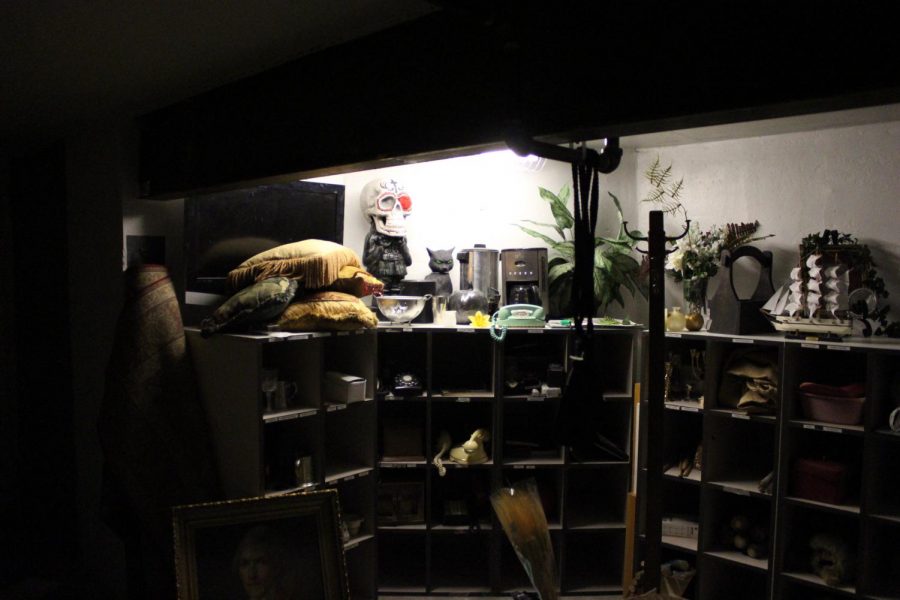The props cage is located underneath the stage in the Performing Arts Center and holds a variety of random items, from fake headstones to old telephones.
The little things: the role of props in a show
Walking into the first of two props meetings for the week, my expectations were based entirely in two facts. One was the concept that I had never really considered the props when I had watched plays and movies in the past. They were, for all intents and purposes, “just there,” helping move the plot along and otherwise not really standing out. Two was a warning Naomi Sherman, the props lead for One Man, Two Guvnors, had given me when I scheduled the shadow. “It’s dusty,” she had said. “The props cage is very, very dusty.”
What greeted me, though, was so much more fascinating than understated items and grime. Over the last two weeks, the props crew has been deep in research and list creation. When the technical cast screened the play together, the props crew took detailed notes on every prop in the show, and they then spent a week of crew meetings creating scene plots. These are created by going through a scene section by section, writing down information such as when each prop is carried onstage, who it is carried by, and how it comes off.
My first day with the props crew began with us determining which category each prop fell into. This year, Colorado State University happened to put on the same show, and Fossil will be borrowing some props from their performance. These include a cutout of a cricket player and several traveling trunks, an outdoor trash can and a sculpture of a lady. Sherman and her crew also plan to use some of CSU’s props as models for those they want to build themselves.
Next, the props crew has to make the call about what they can make themselves and what they need to buy. One Man, in particular, is an extremely prop-heavy show, and so their budget will only stretch to cover the most necessary purchases. For example, the show features a travel brochure as an important plot point, but buying a 1960s travel brochure is expensive because they have now become collectable items. After we spent almost half an hour trying to find a product that cost less than $25 for a single brochure, we decided to search for old brochure covers and create our own with Photoshop.
In researching props for the show, the crew has to consider both time period and geographic setting. One Man takes place in Brighton, England in the 1960s, so all furniture, magazines, and streetlights must echo that. Often the crew begins their research with a simple search of Amazon, Etsy, or Craigslist. “1960s ironing boards” turns up many more ideas than one would think.
Props like handwritten letters and business cards will also be made by the crew; others, including paper designed to be eaten, have to be purchased. Once all the props are collected, the crew will face their next challenge: testing each item to make sure it will hold up for its role in the show. For example, the edible paper must hold its shape despite time in coat pockets and lapels, and props is responsible for ensuring that it will.
The final category of props were those that we figured someone would be willing to loan to the show or that someone else would be responsible for making. Fossil’s National Art Honor Society offered to paint a painting important to the show, for example, and I contributed an old journal to the collection. Those few final props rounded out the exhaustive lists compiled by Sherman and her two sophomore crew members, Max Knoll and Daniel Williams.
My second day of props began frantically. When I arrived in the props cove, which is housed in one of the alcoves in the arts hall, I was almost immediately sent with Sherman to find two very specific items: sandbags and foam sticks. The props crew has several responsibilities other than just gathering and creating the props for the show. They also provide whatever the actors need for their rehearsals, which often is not exactly the same props you will see on show night. For example, actors do not rehearse a fight scene with swords their first time. Instead, they use foam sticks—hence, the request of us.
Props is responsible for managing what is known as the props cage, which is located under the stage in the Performing Arts Center in the pit. There, they store props from previous shows. One Man boasts a number of food props, which means that props had to interview every member of the cast about their allergies. This translated to a complex problems—characters with allergies to a particular food must not only avoid the prop, the props crew has to determine which characters will be touching throughout the show to ensure nothing is spread by human contact.
Sherman expressed the idea that one of the struggles faced within props is having such a small crew. She explained that, when one or two of the three members cannot meet, the others are left to complete work on their own, and the communication gets fuzzy. Sherman also touched on the very same preconception I noted in myself about props: that, “when you go to a show, you don’t look at every aspect tech-wise…but sometimes, when there’s props that really work, like a fire or a fire extinguisher, I feel like it adds to the show in some way. It adds comedy to the show.”
And, indeed, when I sat in the theater to see Captain Marvel the day after my second props shadow, I found myself noticing those very aspects. Photographs hung in a mother’s study give the viewer a little bit of insight into her devotion to her children, while bits of dog tags that have been through explosions must display the logical charring. In exploring the world of props for a week, I discovered a newfound appreciation for the little bits that make up the show and a newfound respect for the thoughtfulness that goes into placing them.

